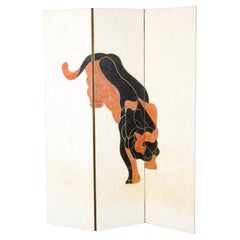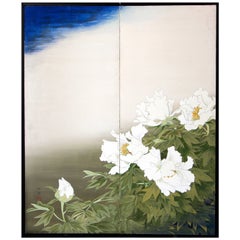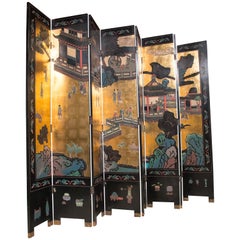ESCABELLE Paintings and Screens
to
1
1
1
1
1
1
1
1
1
1
1
1
Marble 3 leaves screen
Located in grand Lancy, CH
Marble and wood screen , depicting a panther, the back is made of wood and the face is made of a small piece of marble of different color
Category
Vintage 1970s European Paintings and Screens
Materials
Marble
$5,200
Related Items
Two-panel screen
By Japanese Studio
Located in Brescia, IT
Modern two-panel screen with white peonies.
Hand-painted on vegetable paper.
Very fresh work that is easy to incorporate into design furniture.
Very good state of preservation, sig...
Category
20th Century Japanese Showa Paintings and Screens
Materials
Wood, Paper
Large 8-Panel Coromandel Screen
Located in Stamford, CT
A grand eight panel Coromandel screen. The screen has mostly a gilt background with a few architectural structures and figures. A very good looking screen.
Category
Vintage 1950s Asian Paintings and Screens
Materials
Wood
Pair of Japanese Screens
Located in Schellebelle, BE
Exceptional pair of Japanese screens, 20th century
Six parts, six times 45 cm wide
Gold spotted paper with parts of old screens.
Category
Mid-20th Century Japanese Paintings and Screens
Materials
Paper
Golden Mountain Scenery Screen
Located in Fukuoka, JP
This stunning 2-panel screen is a sublime representation of traditional Japanese artistry from the Showa period. It features a delicate and elegant depiction of mountainous landscape...
Category
20th Century Japanese Paintings and Screens
Materials
Textile, Wood
Japanese Six-Panel Screen
Located in Stamford, CT
A six-panel Japanese paper screen with poems, autumn flowers, bamboo fence and Mandarin ducks. Poems are believed to be earlier but were probably...
Category
Antique Mid-19th Century Japanese Edo Paintings and Screens
Materials
Paper
Byobu - Japanese Folding Screen
By Japanese Studio
Located in Brescia, IT
Nice four-panel Japanese screen painted on vegetal paper, depicting a landscape with a red maple, flowers and birds.
The size is very refined and easy to place in a design project.
Category
Mid-20th Century Japanese Showa Paintings and Screens
Materials
Paper
Japanese Kyoto Embroidered Screen
Located in Pasadena, CA
This is a finely stitched Kyoto embroidery screen that dates to the Meiji Era (1868 - 1912). Kyoto has been celebrated for its skilled artistic embro...
Category
Antique Late 19th Century Japanese Japonisme Paintings and Screens
Materials
Brass
Japanese two panels screen
Located in Brussel, BE
Breathtaking Japanese two panels screen. Flowers and birds painted on paper and gold leafs. Hugely decorative as a screen or hanging on a wall. Unique pi...
Category
Antique Late 19th Century Japanese Japonisme Paintings and Screens
Materials
Gold Leaf
Showa Golden Mallow Screen
Located in Fukuoka, JP
This exquisite two-panel screen from the Showa period features a lush depiction of mallows in vibrant hues set against a luxurious golden background. The mallow flower, known in Japa...
Category
20th Century Japanese Showa Paintings and Screens
Materials
Gold Leaf
Edo Period Kyoto Screen
Located in Fukuoka, JP
Edo Period Kyoto Screen
Period: Edo period
Size: 343 x 176 cm (134.6 x 69 inches)
SKU: RJ69
This stunning Edo period screen depicts typical scenes of d...
Category
Antique 18th Century Japanese Edo Paintings and Screens
Materials
Silk, Wood, Paper
Japanese Two Panel Screen: Antique Kimono Fabric Mounted on Screen
Located in Hudson, NY
Japanese Two Panel Screen: Late Nineteenth Century Kimono Fabric Mounted on Early Twentieth Century Screen. In the Heian period (eighth century to the twelfth century), noblemen wou...
Category
Early 20th Century Japanese Meiji Paintings and Screens
Materials
Silk, Wood, Paper
$17,200
H 67.75 in W 74.5 in D 1 in
Peony Blossoms Screen
Located in Fukuoka, JP
Peony Blossoms Screen
Period: Edo period 18-19th century
Size: 212 x 138 cm (83.5 x 54.3 inches)
SKU: PJ105
Experience a rare gem from Japan's heritage – an Edo period peony blosso...
Category
Antique 18th Century Japanese Edo Paintings and Screens
Materials
Silk, Paper


